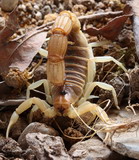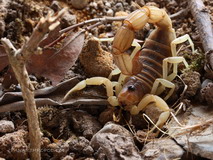- Akravidae
- Bothriuridae
- Buthidae
- Babycurus jacksoni
- Centruroides gracilis
- Centruroides meisei
- Centruroides nigrenscens
- Hottentotta hottentotta
- Lychas mucronatus
- Lychas scutilus
- Parabuthus pallidus
- Parabuthus raudus
- Parabuthus villosus "black"
- Caraboctonidae
- Chactidae
- Chaerilidae
- Euscorpiidae
- Hemiscorpiidae
- Iuridae
- Pseudochactidae
- Scorpionidae
- Superstitioniidae
- Troglotayosicidae
- Typhlochactidae
- Vaejovidae

Parabuthus raudus (Simon, 1888)
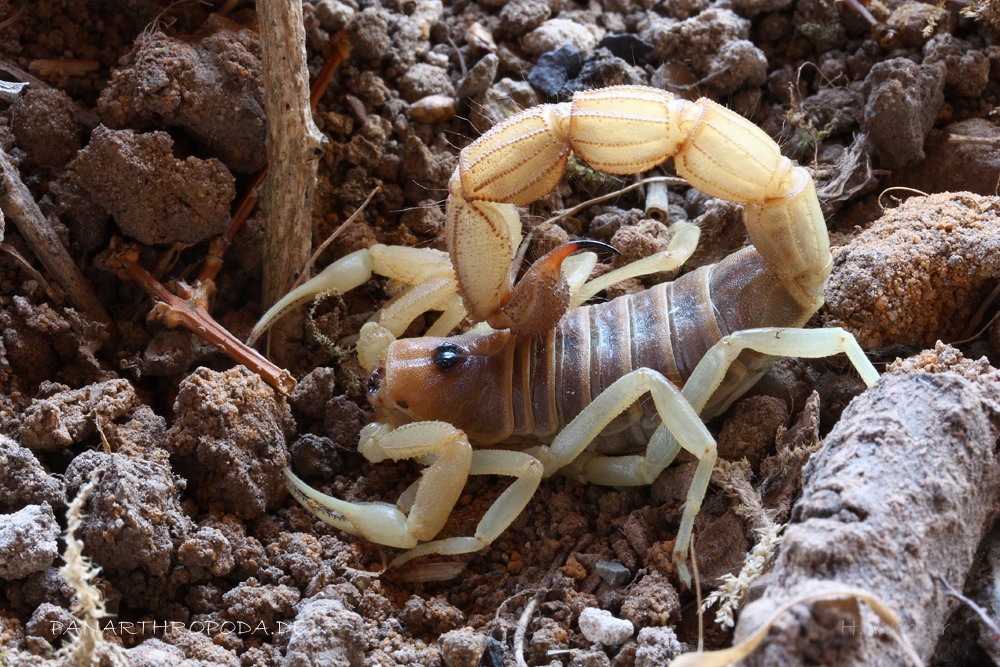
0.1 P. raudus "light morph"
Origin and occurrence
Parabuthus raudus is distributed in Angola, Botswana, Namibia, South Africa, Zambia anb Zimbabwe.
This species is mainly found in the Kalahari sand system and in sandy areas at and around the Orange River.
There it inhabits sandy areas, where it digs tunnels in open land and in the vicinity of bushes and pieces of gras. These tunnels run near to the surface, but are rather long (P. Pumberger, pers. message.).
When the opportunity is present, P. raudus will dig at moist spots (e.g. close to water rinses) (M. Dabs, pers. message.).
P.raudus shares its hole area of distribution with P. granulatus and P. kuanyamarum, in the south western part P. kalaharicus and P. laevifrons can be found, too. (PRENDINI 2004).
The climate in the distribution area is rather dry, the humidity during rainy season and the morning hours can rise non the less.
In relation to the origin temperatures and seasons differ a bit, at http://www.iten-online.ch/klima/afrika/ one can inform oneself about the different climates.
Appearance and sexual dimorphism
Parabuthus raudus has a general yellow base coloration, where walking legs and pedipals are a bit lighter in color then the rest of the body.
The yellow can diverge into more brown colors, in addition the metasomal segments III to V and the telson can be darker colored depending on the origin of the animal. (PRENDINI 2004)
The light as well as the dark color morph can be found in captivity.
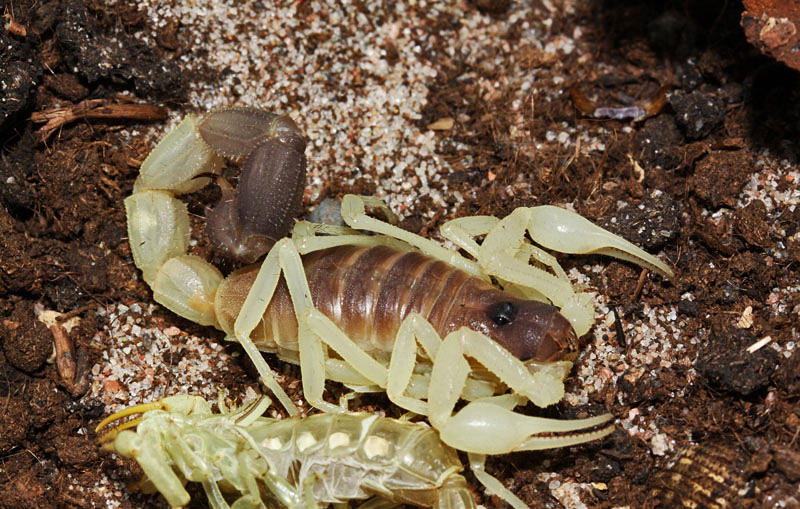
P. raudus "dark morph", shortly after molting. Photo © R. Lind
This species reaches about 8 - 12 cm in bodysize (according to LEEMING 2003 even up to 16 cm), where males stay smaller and are less bulky than the females. As typical for Parabuthus, the pedipals of P. raudus are thin, whereas the metasoma is stick and heavily granulated. Adult males possess thicker, bulkier chelae than females.
The sexes can easily be distinguished by the proximal median lamellae, an enlarged lamella on the innser side of the pectines. Males don't show those proximal median lamellae, whereas females have them. With this method even small juveniles can be sexed properly.
On the photo of the dark morph one can recognize a high similarity to Parabuthus schlechteri. This is not due to chance since both species are closely related. However, there are several attributes with which they can be distinguished. Here ist the most obvious difference:
Whereas only metasomal segments III to V are dark in P. raudus, P. schlechteri shows a completely dark metasoma. (PRENDINI 2004)
When one is not sure about the species, this attribute can be used as orientation.
Keeping conditions
One should try to rebuilt the natural living conditions of P. raudus accurately in a terrarium.
Therefore one can use sandy substrat, added with clay powder, to allow the animals to build tunnels. Decorated with roots, grasses, pieces of bark and stones a few hideouts can be built.
I can not make any statements about keeping this species in groups, but I suppose that at least keeping them in pairs is possible.
A container of 20x30x20 cm (lxbxh) is sufficient for one animal, a 30 cm cube should easily house a pair.
I keep my specimen at between 27 and 32 °C. Directly under the light source (a halogenen spot) even way higher temperatures are possible, where gravid specimen can get their additional dosage of warmth.
The supply of moisture should not be neglected, therefore a bowl (e.g. a lid of a bottle) should be offered and filled every 2 to 3 weeks. In that progress a part of the container can be slightly strayed, too, to raise the humidity for a short period of time - like it would in the habitat.
P. raudus can be fed with everything these animals can subdue: Crickets, roaches, bugs, grasshoppers, here and then a flour worm and so on.
I have never seen a paticular kind of prey not beeing taken, so one can without hesitation offer a divers variation of prey items. The animals should be fed every one to three weeks.
Mating and raising the young
I will not go into this matter at this point due to the lack of own experience. I have however been told by M. Dabs, that he raises his young at maximum of 28 °C and that above this the young started dying.
Behavior and venomousness
No proper sources about the venom of P. raudus are known to me, it should however be assumed, that its venom is rather strong and that a sting can therefore have serious consequences.
In addition P. raudus is said to possess the ability to spray venom when provoked extremely (LEEMING 2003).
As in all Parabuthus spp. one should reduce the handling of these animals to a minimum. Should one however need to handle the animal, extreme caution and concentration are a must.
No general statements concerning the behavior of this species can be made, since I only own one specimen. This specimen has however dug a system of tunnels in which it spends most of its time.
I can only seldom observe the animal out of its tunnels completely. Most of the time it can not be seen or at most shows itself lurking at the entrance.
When the terrarium is opened to offer food or similar my specimen quickly retracts into the tunnels, but shows itself at the entrance a few hours later.
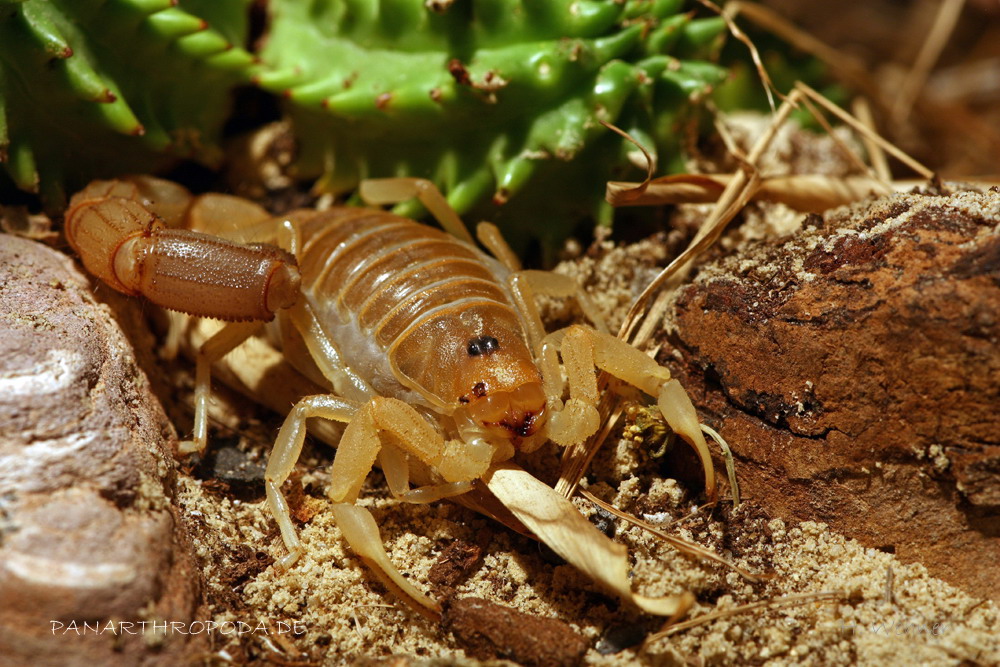
0.1 P. raudus subadult
Comment
Despite of (or perhaps even due to?) the hidden way of life P. raudus is a very attractive species to keep. The deep yellow color (light morph) looks wonderful and because one only sees it seldom, the joy is even stronger when one does.
Sources
-M. Dabs
-Photo P.raudus "dark": R. Lind
-PRENDINI Lorenzo (2004):The Journal of Arachnology 32:109–186; THE SYSTEMATICS OF SOUTHERN AFRICAN PARABUTHUS, POCOCK (SCORPIONES, BUTHIDAE): REVISIONS TO THE
TAXONOMY AND KEY TO THE SPECIES: 171 ff.
-LEEMING Jonathan (2003): Scorpions of southern Africa: 52
-Own experiences and observations
If not mentioned otherwise: Pictures and Text © H. Wehner
Note
This is not a caresheet in the narrower sense, more a fact sheet. The mentioned keeping conditions are those I keep my specimen at. However they seem to work well and I am not about to change them.
Should someone have experiences that contradict mine, I ask for information about this.
H. Wehner, authored 2010
